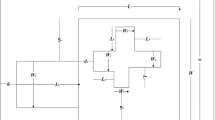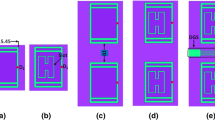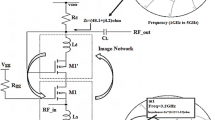Abstract
This paper approaches a novel design theory of Low noise amplifier using reconfigurable rectangular shaped slotted patch antenna for 10.3–14 GHz receiver applications. In this approach, a Berkeley short-channel4 metal oxide field effect transistor (BSIM4, MOSFET) device is loaded in rectangular slotted patch antenna which results in wide band frequency of operation. To understand the design and analysis of low noise amplifier, an equivalent circuit model is extracted from the rectangular slotted patch antenna using finite element method (FEM) simulator where the slotted effect is considered. An extraction of equivalent model from the slotted patch antenna results in the L–C circuit which is used to perform an impedance transformation for low noise amplifier. A 12 GHz low noise amplifier using L–C circuit can improve performance parameters as per designer’s requirement. A reconfigurable MOS loaded slotted patch antenna is verified using momentum microwave simulator and a wide bandwidth of 9 GHz in the frequency range of 10.3–19.3 GHz is achieved. The Low noise amplifier is simulated with TSMC 0.09 µm mixed signal/RF CMOS process technology. The post-layout circuit simulation results show that the proposed common source LNA with L–C network achieves a maximum power gain of 20 dB with the −3 dB bandwidth from the range of 10.3–13.6 GHz. A reflection coefficient of −14 dB and minimum noise figure of 1.6 dB is achieved. The power dissipation is 2.5 mW at 1.2 V supply voltage.
















Similar content being viewed by others
References
Al-Attar, T., & Lee, T. H. (2005). Monolithic integrated millimeter-wave IMPATT transmitter in standard CMOS technology. IEEE Transactions on Microwave Theory and Techniques, 53, 3557–3561.
Al-Attar, T., Mulligan, M. D., Lee, T. H. (2004) Lateral IMPATT Diodes in Standard CMOS Technology. In IEEE international electron devices meeting (pp. 459–462).
Tawk, Y., Costantine, J., Avery, K., & Christodoulou, C. G. (2011). Imple-mentation of a cognitive radio front-end using rotatable controlled re-configurable antennas. IEEE Transactions on Antennas and Propagation, 59, 1773–1778.
Schaubert, D., Farrar, F., Sindoris, A., & Hayes, S. (1981). Microstrip an-tennas with frequency agility and polarization diversity. IEEE Transactions on Antennas and Propagation, 29, 118–123.
Bhartia, P., & Bahl, I. J. (1982). Frequency agile microstrip antennas. Microwave Journal, 25, 67–70.
Yang, F., & Rahamt-Samii, Y. (2005). Patch antennas with switchable slots (PASS) in wireless communications: Concepts, designs, applications. IEEE Antennas Propagation, 47, 13–29.
Pues, H., & van de Capelle, A. (1984). Accurate transmission-line model for the rectangular microstrip antenna. Microwaves, Optics and Antennas, IEE Proceedings H, 131, 334–340.
Hammerstad, E., Jensen, O. (1980) Accurate models for microstrip computer-aided design. Microwave symposium Digest, IEEE MTT-S International, 407–409.
Kirschning, M., Jansen, R. H., & Koster, N. H. L. (1981). Accurate model for open end effect of microstrip lines. Electronics Letters, 17, 123–125.
Kumar, S., kanaujia, B. K., Pandey, G. P., & Singh, D. K. (2015). A miniurazation approach towards 40 GHz single chip reciever system for MMW Communication networks. Wireless Personal communication. doi:10.1007/s11277-015-2688-4.
Shigematsu, H., Hirose, T., Brewer, F., & Rodwell, M. (2005). Millimeter wave CMOS circuit design. IEEE Transactions on Microwave Theory and Techniques, 53, 472–477.
Doan, C. H., Emami, S., Nikneiad, A. M., & Brodersen, R. W. (2005). Millimeter-wave CMOS design. IEEE Journal of Solid-State Circuits, 40, 144–155.
Sun, K. J., Tsai, Z. M., Lin, K. L., & Wang, H. (2006). A noise optimization formulation for CMOS low-noise amplifiers with on-chip low-Q inductors. IEEE Transactions on Microwave Theory and Techniques, 54, 1554–1560.
Queudet, F., Pele, I., Froppier, B., Mahe, Y., Toutain, S. (2002). Integration of pass-band filters in patch antennas. In 32nd European microwave conference, Milan (Vol. 35, pp. 685–688).
Khidre, A., Yang, F., & Elsherbeni, A. Z. (2015). A patch antenna with a Varacter loaded slot for reconfiguarble dual band operation. IEEE Transcation on Antennas and Propagation, 63, 755–760.
Shaeffer, D. K., & Lee, T. H. (1997). A 1.5-V, 1.5-GHz CMOS low noise amplifier. IEEE Journal of Solid-State Circuits, 32, 745–759.
Acknowledgement
This work was supported by Inje University Grant 2016 and 2017.
Author information
Authors and Affiliations
Corresponding author
Rights and permissions
About this article
Cite this article
Kumar, S., Kanaujia, B.K., Dwari, S. et al. Design and Analysis of Low Noise Optimization Amplifier Using Reconfigurable Slotted Patch Antenna. Wireless Pers Commun 97, 5185–5200 (2017). https://doi.org/10.1007/s11277-017-4774-2
Published:
Issue Date:
DOI: https://doi.org/10.1007/s11277-017-4774-2




